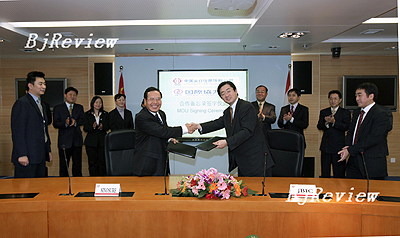
That's the view of Lin Jiujiang, Vice General Manager of the Marketing Department of China Export & Credit Insurance Corp., who speaks to Beijing Review about his organization's experience in this field.
Beijing Review: What are your views on the urgent brand building of Chinese enterprises in cooperation with the growing development of China's export trade?
Lin Jiujiang: In 2006, China's export volume amounted to $969.1 billion, ranking third in the world. While it is expanding rapidly, the export quality needs to be improved, and the facelift of Chinese brands needs to be enhanced. Studies reveal that most of the exports of Chinese enterprises are through processing trade and contract manufacturing, while export enterprises that have independent brands account for less than 20 percent. Among them, international brands are few. Take Guangdong Province as an example, its export volume accounts for one third of China's total exports, but the export volume of its independent brands only have a share of 3 percent of its total exports. The export amounts of independent brands of Shanghai and Zhejiang Province also make up less than 10 percent of local foreign trade.
What is the reason for the slow pace of the international presence of Chinese brands?
There are objective and subjective reasons.
Seen objectively, we know that it hasn't been long since export enterprises began to compete internationally, which increases the difficulties of the export of Chinese brands. The competition in the international market is very fierce, which makes it difficult for Chinese brands to survive. Consumers are already loyal to certain famous international brands, so Chinese brands cannot break through. For example, in European and American markets consumers have their favorite consumption brands and ideas. Finally, the cost of tapping the international market is too high, making it out of the reach of Chinese export enterprises.
Subjectively, some Chinese export enterprises don't want to take risks and are eager for quick success and instant benefits and their investment in building up independent brands is inadequate. Worse still, the protection of independent brands and trademarks is not strong, while the inadequacy of international publicity and the lack of core technologies result in weak brand strategy and the cut-throat competition among Chinese enterprises discourage their initiative to build up independent brands.
What advice would you give to Chinese brands trying to make inroads into overseas markets?
The first problem is the low recognition of Chinese brands. The expanded exports of industrial products with low added value have caused negative impacts on China's foreign trade and the national economy. This is disadvantageous to the increase of benefit exchanges in the international market, the sustainable development of the economy and the improvement of international competitiveness.
The second problem is related to increasing trade barriers, the lack of independent brands, low added value and low export prices. Currently, anti-dumping cases and safeguard measures against China account for 17 percent of the global total. China has run into a variety of protective measures taken by other countries, which are allowed by WTO rules.
It's a systematic project to build up independent brands, and the project should be actively joined by enterprises, government and intermediary organizations, so as to realize the transition from less-known brands to well-known ones.
Enterprises should first strengthen the buildup of independent brands by increasing their brand consciousness, choosing an appropriate model for the buildup of independent brands, improving the product quality and design, finding suitable access points in the market, improving advertising campaigns and establishing an international marketing network.
The government should energetically promote Chinese brands by devising development plans for these brands, providing various supports to increase the international competitiveness of the products, strengthening the protection of intellectual property rights, establishing a public information service platform and raising the competitiveness of the brands.
The intermediary organizations should act as bridges to give impetus to the development of Chinese brands. They should be encouraged to establish partnerships and develop dialogue mechanisms with foreign counterparts, as well as to make full use of resources available to provide enterprises with training, consultation and agency services, so as to reduce their costs and risks.
What efforts has your corporation made in supporting Chinese enterprises with independent brands to develop their international business?
In order to implement the spirit of the Central Government to increase the amount of well-known independent brands and support the healthy development of the enterprises with independent brands and innovative abilities, through promulgating supporting policies with government departments and raise insurance coverage, China Export & Credit Insurance Corp. (Sinosure) has already strengthened its support to 190 enterprises with well-known independent brands since 2005.
| 